|
|
|
|
|
|
While permanent way works are taking place or for other reasons it may be necessary to temporarily restrict the speed of trains to less than the normally permitted speed. The earliest method of advising drivers entailed positioning a handsignalman at the site of the temporary speed restriction (TSR), with a further handsignalman positioned half a mile (0.8 km) or so on the approach. The latter would place a detonator on the rail and exhibit a green handsignal waved slowly from side to side.
|
The warning board was introduced by 1903, for positioning on approach to a TSR that was to continue for a long period of time. If a warning board was erected, the second handsignalman and the detonators could be dispensed with, except during fog or falling snow. The arrow shape and green colour of the warning board [14.1] were clearly derived from the 'caution' indication of the Great Western Railway's 'caution board' (see [1.31]). After sunset or during fog or falling snow, one green and one white lamp were displayed side by side in the warning board. Some other companies adopted the same style of warning board. |
|
|
In cases where a warning board could not be accommodated inside a tunnel because of limited clearance, it could be substituted by a green light over a white light [14.2]. |
|
If a warning board was erected, the beginning and end of the restriction might be marked by a commencement indicator and a termination indicator, respectively, instead of by handsignalman. Normal speed may be resumed as soon as the rear of the train has passed the termination indicator. On the Great Central Railway, the commencement indicator was a green oval board, which displayed two green lights side by side at night [14.3], and the termination indicator was a white diamond-shaped board showing one green light at night [14.4]. The Great Eastern Railway placed a green banner and green light at the commencement of the restriction and used a termination indicator in the form of a tall white board shaped like a letter "T", showing a white light at night [14.5].
 |
 |
 |
|
[14.3] Commencement Indicator.
Area: GCR Usage: High Status: Historical |
[14.4] Termination Indicator.
Area: GCR Usage: High Status: Historical |
[14.5] Termination Indicator.
Area: GER Usage: High Status: Historical |
|---|
From 1914, London & North Western Railway practice was to place an indicator below the warning board, showing the speed in miles per hour that the train's speed must be reduced to [14.6]. The LNWR's commencement and termination indicators comprised white circular boards bearing the letters "C" and "T", respectively [14.7 & 14.8].
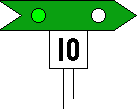 |
 |
 |
|
[14.6] Warning Board with Speed Indication.
Area: LNWR Usage: High Status: Historical |
[14.7] Commencement Indicator.
Area: LNWR Usage: High Status: Historical |
[14.8] Termination Indicator.
Area: LNWR Usage: High Status: Historical |
|---|
|
From c.1916, the illuminated speed indications at LNWR warning boards were exhibited above the warning board [14.9]. |
|
Standard signage for TSRs was introduced nationally in July 1917. This included the existing style of warning board (see [14.1] and [14.9]) as well as new forms of commencement and termination indicators. The commencement indicator had a black letter "C" on a white background [14.10], and the termination indicator had a white "T" on a black background [14.11]. Both indicators were illuminated. For a TSR located inside a long tunnel, the commencement and termination indicators could be dispensed with and audible signals given instead by means of gongs.
 |
 |
|
[14.10] Commencement Indicator.
Area: All Areas Usage: High Status: Historical |
[14.11] Termination Indicator.
Area: All Areas Usage: High Status: Historical |
|---|
|
Where a commencement indicator could not be accommodated inside a tunnel, an alternative arrangement was to display three vertical white lights instead [14.12]. |
|
The warning boards were altered to have white edges c.1924 [14.13 & 14.14]. The ex-LNWR practice of displaying the speed above the warning board [14.14] was subsequently followed on all LMS lines. Around 1944, the GWR and the Southern Railway adopted the same practice, but the LNER did not.
 |
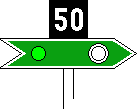 |
|
[14.13] Warning Board.
Area: Various Usage: High Status: Historical |
[14.14] Warning Board with Speed Indication.
Area: LNWR (subsequently All Areas except LNER) Usage: High Status: Historical |
|---|
In November 1938, following its earlier decision to use floodlighted shunting signals in colour light signalling areas (see [4.80 - 4.83]), the Southern Railway introduced electrically floodlighted TSR warning boards for use in those areas. The floodlighted warning boards, which continued to show green and white lights, obviated the requirement for handsignalmen to be stationed at them during fog or falling snow.
|
Exceptionally, an illuminated arrow indicator was fitted to the post of a warning board [14.15] to indicate that the related commencement indicator was situated on a left-hand or right-hand divergence ahead. |
|
|
From 1948, the warning boards were repainted yellow, by then the long-accepted colour meaning 'caution'. Two lamps with yellow lenses were exhibited at night [14.16]. |
|
Some commencement indicators and termination indicators had a non-standard appearance [14.17 & 14.18].
 |
 |
|
[14.17] Non-standard Commencement Indicator.
Area: Various Usage: Medium Status: Historical |
[14.18] Non-standard Termination Indicator.
Area: Various Usage: Medium Status: Historical |
|---|
Gas-lit warning boards, which were on trial from December 1963, exhibited two white lights [14.19] in place of the usual yellow lights (see [14.16]). The gas-lit lights were brighter than the usual oil-lit lights. A gas-lit warning board with one white light in the centre of the board [14.20] was on trial alongside the Down Main line near Repton & Willington station (London Midland Region) in 1965.
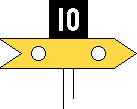 |
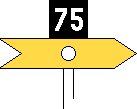 |
|
[14.19] Gas-lit Warning Board.
Area: Various Usage: High Status: Historical |
[14.20] Experimental Gas-lit Warning Board.
Area: Repton & Willington Usage: Low Status: Historical |
|---|
The Operating Committee recommended in July 1965 that commencement indicators (see [14.10]) be replaced by speed indicators, which display the TSR speed [14.21] in addition to the speed indication at the warning board. Speed indicators were introduced in May 1968, as were differential speeds for TSRs. Where differential speeds apply, the speed indicator displays two speeds, one above the other [14.22]. The associated warning board also showed both speeds; one above the arrow board and one below [14.23]. The speeds apply as follows:
 |
 |
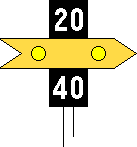 |
|
[14.21] Speed Indicator.
Area: All Areas Usage: High Status: Historical |
[14.22] Differential Speed Indicators.
Area: All Areas Usage: High Status: Historical |
[14.23] Warning Board for a Differential TSR.
Area: All Areas Usage: High Status: Historical |
|---|
|
|